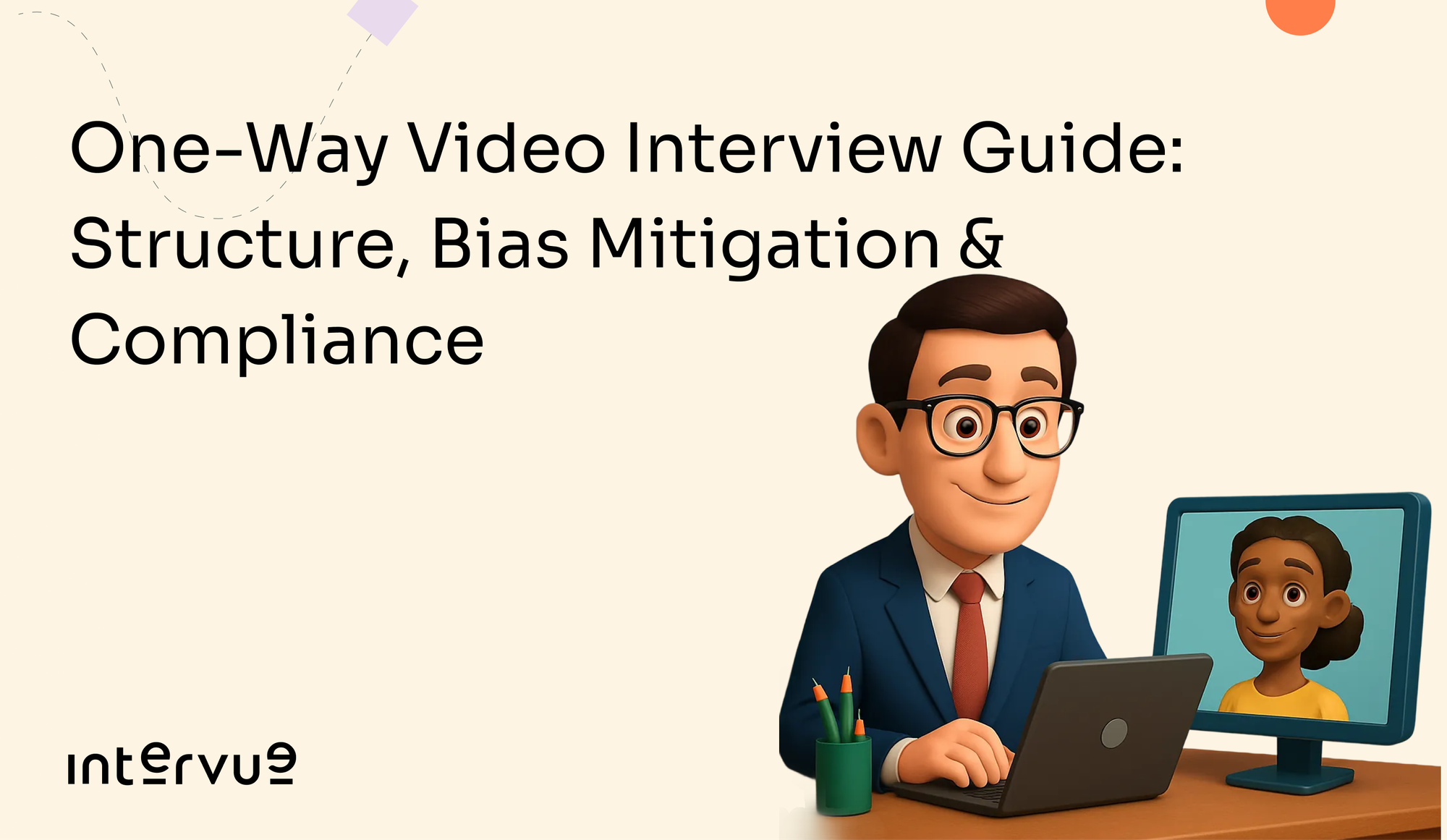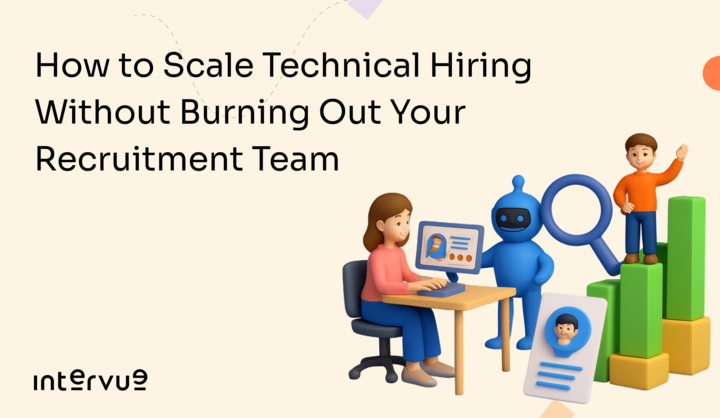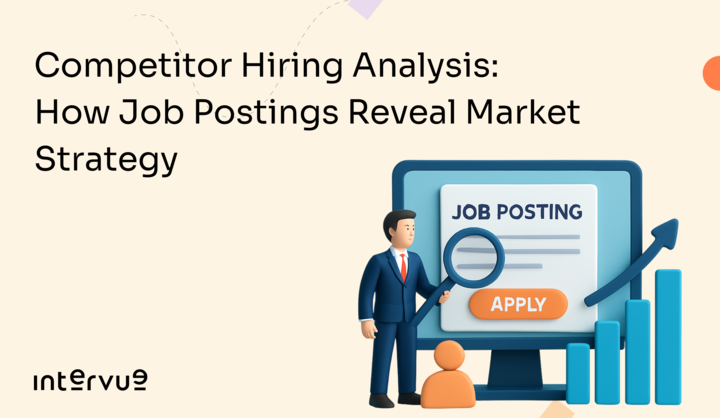One-Way Video Interview Guide: Structure, Bias Mitigation & Compliance
Unlock 75% screening time reduction with one-way video interviews. Learn how Decision Intelligence, structured rubrics, and compliance frameworks mitigate bias risk.

The Enterprise Guide to One-Way Video Interviewing: Achieving Scale Without Bias
One-way video interviews—also known as asynchronous video interviews (AVI)—have become a foundational element of enterprise hiring architecture. As talent acquisition teams accelerate remote hiring and global workforce strategies, AVI offers immense screening efficiency. Yet with this scale comes heightened scrutiny: legal compliance, algorithmic fairness, and candidate experience concerns now sit at the centre of leadership decision-making.
This guide synthesises market data, compliance frameworks, and Decision Intelligence methodologies to help enterprise teams implement AVI responsibly, without falling into the traps of bias, pseudoscience, or operational inconsistency.
The Efficiency Imperative: Modernising Initial Screening
Recruiters describe the traditional hiring process as an “endless marathon of scheduling nightmares and repetitive screening calls”. Research consistently shows that up to 78% of recruiter time is spent on administrative work—coordination, calendar management, follow-ups, and note-taking.
One-way video interview platforms directly remove this administrative burden.
How AVI solves the scheduling puzzle
One-way interviews allow candidates to record responses at a time and place that suits them—particularly beneficial for candidates in different time zones, with caregiving responsibilities, or those working full time. This flexibility directly expands your accessible talent pool.
Why enterprise hiring needs AVI now
- High-volume roles generate thousands of applications.
- Live screening calls cannot scale proportionally.
- The global shift toward hybrid and remote teams demands asynchronous hiring methods.
AVI is no longer a “tech upgrade”; it is the operational backbone for high-volume, modern, distributed hiring functions.
The Explosive Growth and Strategic ROI of AVI Technology
The AVI market is rapidly expanding—from $250.06 million in 2022 to an expected $891.86 million by 2030. This adoption is driven by hard, measurable ROI, not hype.
Quantifiable ROI leadership teams care about
- 75% reduction in time spent screening candidates.
- Up to 7 days faster time-to-hire.
- 46% increase in likelihood of successful hires when AI analytics are properly applied (HBR).
- Substantial recruiter workload reduction and reallocation toward strategic partnership.
This shift is reinforced by wide enterprise adoption reported by Gartner and increased digital hiring productivity supported by Deloitte and McKinsey.
Standardisation and Candidate Experience
One-way video interviews, when executed with good design, significantly improve candidate fairness and experience.
Standardisation: every candidate, identical conditions
AVI ensures:
- the same questions,
- the same time limits,
- the same context,
creating a more consistent baseline for comparing candidates.
Candidate-friendly features that matter
- Ability to re-record answers to reduce anxiety.
- Clear instructions and practice questions.
- Predictable time limits.
- Transparent expectations.
When these features are absent, candidate dropout rates rise. When present, one-way interviews are perceived as efficient, fair, and modern.
Core Implementation Factors for a Defensible Process
Enterprise adoption of AVI requires more than uploading a few video questions. It must be implemented through a legally defensible, structured, and validated framework.
Question Design
- Use job-related, competency-based questions.
- Avoid personality or vague behavioural inference questions.
- Recommended: 5–7 total questions.
Time Limits
- 60–90 seconds for general screening questions.
- 2–3 minutes for scenario-based or technical reasoning questions.
Technical Integrity
To reduce abandonment and ensure equity, AVI platforms must offer:
- device and browser flexibility,
- clear troubleshooting steps,
- session recovery,
- robust recording quality,
- accessible instructions for first-time users.
Ensuring Compliance: The ADA Mandate
One-way video interviews do not inherently violate the ADA. However:
- Employers must provide a reasonable accommodation upon request.
- Candidates unable to participate due to disability must be offered an equivalent alternative (e.g., phone or live interview).
- AI tools that evaluate speech patterns, facial expressions, or tone may unintentionally screen out individuals with disabilities—breaching ADA requirements.
This is essential for enterprise risk mitigation and should be documented in every organisation’s hiring policy.
The Core Challenge: Mitigating Algorithmic Pseudoscience and Bias
Despite AVI’s efficiency, legacy AI approaches introduced critical vulnerabilities.
AI-Enabled Phrenology Risks
Some legacy AVI systems attempted to infer capability through:
- micro-expressions,
- tone modelling,
- gaze tracking,
- nonverbal cues.
These practices have been widely criticised as “AI-enabled Phrenology”—drawing parallels to discredited pseudoscience that claimed character traits could be judged by physical appearance.
Scientific limitations
There is no consensus that AI can reliably infer emotions or traits from pixel-level data. These systems show:
- higher error rates for darker-skinned candidates,
- gendered performance disparities,
- volatility based on lighting, camera quality, and background noise.
The “Creepy Ambiguity Score”
Research shows that when candidates feel watched or analysed by opaque AI systems, their self-reported performance drops. This “creepy ambiguity score” unfairly penalises otherwise qualified applicants and increases the perception of surveillance.
This is why modern AVI must decouple from emotion inference entirely.
The Legal and Auditing Imperative
The Title VII problem
Opaque AI models amplify legal risk because discrimination becomes:
- harder to detect,
- harder for candidates to prove,
- easier for employers to defend as “business necessity.”
The Lex Informatica framework
Legal scholars advocate for ex ante design safeguards—building fairness, transparency, and auditability directly into the technology rather than retrofitting fixes reactively.
Enterprise hiring leaders must ensure that AVI systems:
- produce structured, documentable evaluations,
- provide transparent scoring,
- avoid non-job-related signals,
- maintain complete audit trails.
Anything less invites regulatory exposure.
Intervue’s Unified OS: Criterion-Based Decision Intelligence
Intervue.io’s Interview OS brings the structural sophistication necessary to make one-way video interviewing both scalable and defensible.
Bias-Free Evaluation (Anti-Phrenology Approach)
Intervue deliberately avoids analysing:
✘ facial expressions
✘ micro-movements
✘ tone or emotion inference
These have no proven criterion validity and introduce significant demographic bias.
Instead, Intervue’s AI models evaluate only job-related inputs—the substance of a candidate’s response, aligned to required competences.
Structured Rubrics for Consistency
Intervue enforces structured, measurable criteria via:
- role-specific rubrics,
- defined scoring ranges,
- mandatory justification fields,
- cross-reviewer alignment.
This removes subjective impressionism and ensures every candidate is assessed against defensible standards.
Calibrated Interview Panels
Hiring teams gain:
- shared scoring guides,
- collaborative review workflows,
- rating moderation,
- variance detection.
This creates equal marking—something difficult to achieve in decentralised or ad hoc review processes.
Transparent Audit Trails
Every decision is logged and traceable.
This is essential for:
- Title VII defence,
- ADA accommodation tracking,
- internal audits,
- regulatory compliance,
- consistent decision-making across teams or locations.
Intervue converts AVI from a potential liability into a demonstrably fair, transparent, and scalable process.
Transforming AVI from Compliance Risk to Strategic Advantage
One-way video interviewing offers unmatched efficiency for enterprise hiring teams. But without structured rubrics, accessible design, and scientifically valid scoring, AVI can expose organisations to legal and reputational risk.
Intervue.io addresses these challenges directly—anchoring one-way interviews in Decision Intelligence, criterion validity, and complete transparency. This ensures that your pursuit of speed never compromises fairness, compliance, or candidate trust.
Intervue:
Build a defensible, scalable hiring process. Request a demo of Intervue.io’s Decision Intelligence Platform.
Book a Demo
FAQs
1. How much time can one-way video interviews save?
Most organisations report up to a 75% reduction in initial screening time by replacing phone screens and scheduling coordination with asynchronous video workflows.
2. What are the key criticisms of AI analysis in one-way interviews?
The leading critique is “AI-enabled Phrenology”—the use of unproven emotion recognition or facial analysis that often reinforces racial and gender biases.
3. Must employers offer accommodations for disabled candidates?
Yes. Under ADA guidelines, employers must provide a reasonable accommodation or an alternative interview format upon request.
4. How long should candidate responses be in a one-way video interview?
Best practice: 60–90 seconds for general questions, and 2–3 minutes for scenario-based or technical reasoning.
5. What is the “creepy ambiguity score”?
It reflects candidate discomfort or privacy concern with AI-driven video analysis. Higher scores correlate with lower self-reported performance—meaning discomfort can unfairly disadvantage good candidates.



